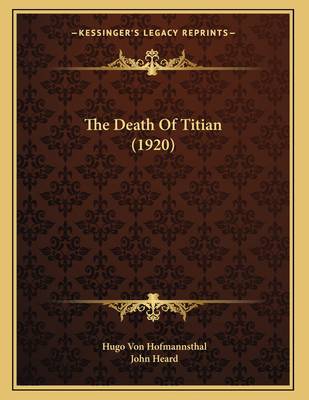
- Retrait gratuit dans votre magasin Club
- 7.000.000 titres dans notre catalogue
- Payer en toute sécurité
- Toujours un magasin près de chez vous
- Retrait gratuit dans votre magasin Club
- 7.000.000 titres dans notre catalogue
- Payer en toute sécurité
- Toujours un magasin près de chez vous
Description
The Death of Titian is a novel written by Hugo Von Hofmannsthal and published in 1920. The story is set in Venice during the year 1576, and it revolves around the death of the famous painter, Titian. The novel is a fictionalized account of the events that took place during the last days of Titian's life.The narrative is divided into three parts, each of which is told from the perspective of a different character. The first part is narrated by a young painter named Pietro, who is a prot�����g����� of Titian. Pietro is deeply affected by the death of his mentor and spends the majority of the novel reflecting on the lessons he learned from Titian.The second part of the novel is narrated by a wealthy Venetian named Alvise. Alvise is a patron of the arts and is deeply invested in the world of painting. He is also a close friend of Titian and is devastated by his death. Alvise spends much of the novel contemplating the nature of art and the role that artists play in society.The final part of the novel is narrated by a monk named Fra Benedetto. Fra Benedetto is a devout Catholic who is deeply troubled by the worldliness of the art world. He is critical of Titian's work and sees it as a reflection of the corruption and decadence of Venice.Throughout the novel, Hofmannsthal explores themes of art, mortality, and the nature of creativity. He also provides a vivid portrait of Venice during the 16th century, capturing the city's beauty, decadence, and political intrigue. The Death of Titian is a thoughtful and introspective novel that offers a unique perspective on one of the most important artists of the Renaissance.This scarce antiquarian book is a facsimile reprint of the old original and may contain some imperfections such as library marks and notations. Because we believe this work is culturally important, we have made it available as part of our commitment for protecting, preserving, and promoting the world's literature in affordable, high quality, modern editions, that are true to their original work.
Spécifications
Parties prenantes
- Auteur(s) :
- Editeur:
Contenu
- Nombre de pages :
- 28
- Langue:
- Anglais
Caractéristiques
- EAN:
- 9781166907815
- Date de parution :
- 10-09-10
- Format:
- Livre broché
- Format numérique:
- Trade paperback (VS)
- Dimensions :
- 216 mm x 279 mm
- Poids :
- 117 g







